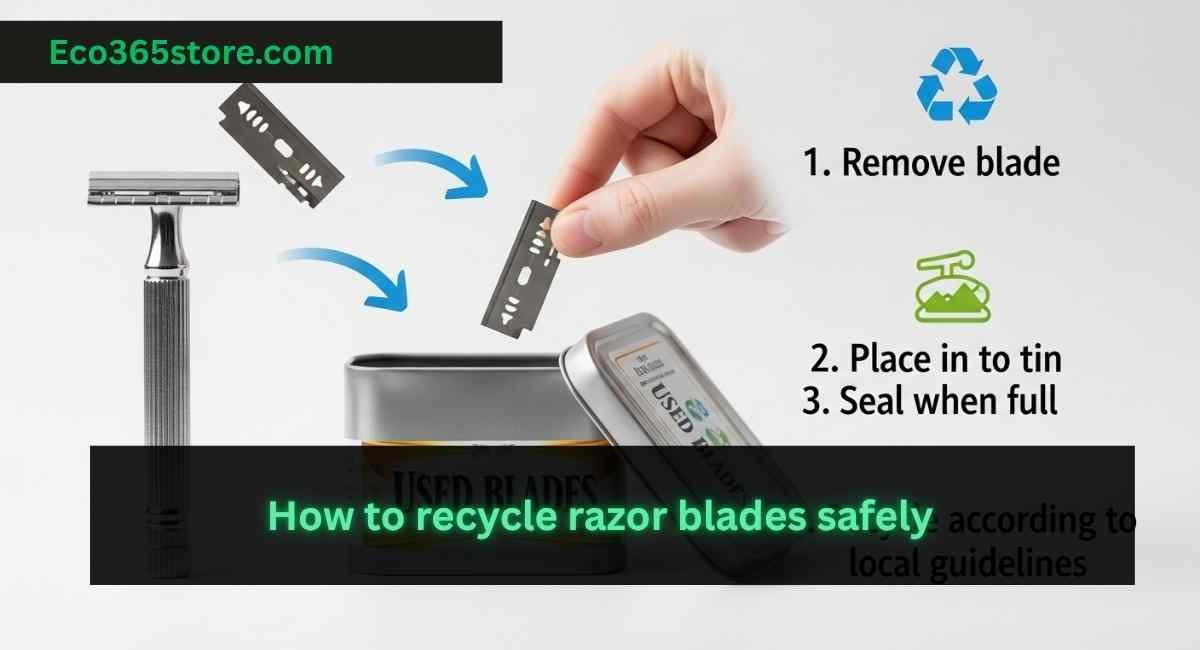Razor blades are small, but the problem they create isn’t. Between disposable shaving razors, multi‑blade cartridges, and double‑edge (DE) blades, billions of units are sold every year. Most of them end up buried in trash bags—where they can injure workers, harm wildlife, and waste perfectly recyclable steel. Learning how to recycle razor blades safely protects people, keeps metal in circulation, and turns your daily grooming into a greener habit.
Why Recycling Razor Blades Matters for the Planet
Environmental Impact: The Hidden Waste of Disposable Blades in Landfills
- Mixed materials: Many cartridges combine tiny steel blades with plastic handles, rubber strips, and adhesive—materials that don’t separate easily in curbside systems.
- Long life in landfills: Steel lasts virtually forever when buried; meanwhile, the plastic packaging and plastic covers that ship with a pack of razor blades add even more bulk.
- Safer streams: Loose blades can slice sorting belts, puncture bags, and injure handlers. Proper containment is essential.

How Recycling Supports a Circular Economy
Steel is infinitely recyclable. When you collect stainless steel DE blades or the metal bits from cartridges and send them to the right facility, they’re melted and reborn as new products. That means less mining, lower energy use, and fewer emissions. A blade that shaved you this month can be part of a bicycle, a pan, or even a new metal receptacle next year.
Safety Beyond Shaving — Protecting People and the Environment from Harm
Proper blade recycling prevents cuts for sanitation teams, protects animals that scavenge in open dumps, and reduces the chance of sharp waste escaping into soil and waterways. It also sets a standard at home: kids and pets should never have access to exposed sharps.
Understanding Razor Blade Disposal Risks and Safety Essentials
Safe Handling and Immediate Storage: Your First Line of Defense
- Handle by the short, dull edges—never the blade’s cutting surface.
- Rinse and pat dry before storage (reduces rust so containers last longer).
- Drop the blade directly into a designated container without passing it around.
Why Used Blades Should Never Be Thrown Away Loose
Loose blades cut through trash bags, jam recycling machines, and endanger people. Even “dull” blades can pierce skin. Many cities treat blades like sharps; fines or rejected pickup can result from improper disposal.
Prioritizing Safety: How to Handle Used Razor Blades with Care
- Change blades on a flat, well‑lit counter.
- Keep a magnet handy to nudge a blade without touching the edge.
- If you nick yourself, sanitize the area and pause—rushing is when accidents happen.
Essential Tools for Safe Blade Storage
- Blade bank or blade disposal tin (purpose‑built metal box with a slit)
- Sealed sharps container from a pharmacy
- DIY metal receptacle (e.g., mint or coffee tin) labeled “SHARPS—RAZOR BLADES”
- Thick plastic bottle with a screw cap (last resort); label prominently and tape the cap
Using Blade Banks and Sharps Containers for Home Safety
A blade bank is inexpensive, unobtrusive, and lasts years. When full, you can drop the whole tin at approved collection locations, a scrap‑metal facility (policy‑dependent), or a sharps program.
Temporary Safe Storage Tips Until Proper Recycling
Traveling? Use a pocket blade bank or tape a blade securely in thick paper, then place it in your tin at home. Flying? Pack used blades only in checked baggage and review airline rules in advance.
Types of Razors and Their Recycling Options
Double‑Edge Razor Blades (Safety Razors): The Easiest to Recycle
DE blades are single‑material stainless steel. That makes them the simplest candidates for metal recycling—no plastic handles to separate, no adhesives to scrape.
Why Stainless Steel DE Blades Are Ideal for Sustainable Shaving
- 100% recyclable when contained properly
- Sold with minimal packaging by many brands of blades
- Compatible with metal handles that last decades (handles for reuse)
Disposable Razors and Multi‑Blade Cartridges: The Recycling Challenge
The Problem with Mixed Plastic and Metal Materials
Cartridges fuse steel and plastic, and some have lubrication strips. Most curbside programs can’t separate these tiny parts, so you’ll need specialty programs (see TerraCycle and brand take‑backs).
Straight Razors: The Near Zero‑Waste Option
Long‑Term Maintenance vs. Disposal
A straight razor uses no disposable blade at all. With stropping and occasional honing, it can last a lifetime—extremely low waste and often fewer incidents of razor burn due to a sharper, well‑maintained edge.
Electric Shavers: Recycling as E‑Waste
How to Recycle Batteries and Motors Responsibly
Electric shavers contain motors, circuit boards, and rechargeable batteries. Treat them like e‑waste: drop off at electronics stores, municipal e‑waste events, or battery programs (e.g., Call2Recycle). Do not place them in curbside recycling.
Dedicated Razor Blade Recycling Programs and Drop‑Off Options
TerraCycle: A Global Solution for Difficult‑to‑Recycle Items
How TerraCycle’s Razor Blade Recycling Works
TerraCycle partners with brands and retailers to collect disposable shaving razors, cartridges, plastic handles, and packaging. You can:
- Use a free brand‑sponsored program when available,
- Buy a Zero Waste Box for bathroom sharps, or
- Drop off at a participating store (availability varies by region).
Brand‑Specific Recycling Initiatives
Gillette®, Schick®, and Other Razor Brands’ Take‑Back Programs
The Gillette Recycling Program (often run via TerraCycle) has offered mail‑back or in‑store collection of all brands—cartridges, disposable razors, and plastic packaging. Schick® has run similar initiatives in select markets. These programs open and close periodically; always confirm current rules, accepted items, and label requirements.
Exploring Local and Alternative Recycling Options
How to Contact Your Local Recycling Centre or Waste Management Company
Call or check your city website for “razor blades,” “sharps,” or “scrap metal.” Ask specifically:
- Do you accept sealed blade banks?
- Are stainless steel DE blades accepted with scrap metal?
- Where is the nearest Drop off or HHW event?
Using Scrap Metal Recycling Facilities for Stainless Steel Blades
Some scrap yards accept sealed metal blade banks labeled “Stainless Steel Razor Blades.” Policies vary—phone ahead.
Household Hazardous Waste (HHW) or Sharps Disposal Programs
Many municipalities run quarterly HHW days or maintain permanent collection centers. While primarily for medical sharps, some accept non‑medical blades if sealed properly. Bring proof of residency and follow their packaging rules.
Beyond Recycling: Reducing Shaving Waste and Going Green
Invest in Environmentally‑Friendly Razor Systems
Refillable Handles, Stainless Steel Blades, and Minimal Plastic Packaging
Switching to a metal safety razor with a sturdy handle and DE blades in paper sleeves slashes lifetime waste. A good handle lasts decades; you’re only recycling the thin steel blades.
Embrace the Art of Wet Shaving
Longevity, Performance, and Eco‑Impact Compared to Disposables
Wet shaving with a safety or straight razor often yields fewer passes and less irritation. Solid soap pucks in tins, alum blocks, and refill brushes eliminate a lot of bathroom plastic.
Consider Electric Shavers as a Waste‑Reducing Alternative
Reducing Blade Disposal Frequency
If electric shaving suits your skin and routine, you’ll dispose of blades far less often—just remember to recycle the device and battery at end‑of‑life.
Pro tip: The same safe‑storage rules apply to other small blades in the house—snap‑off utility knife segments, craft blades, and dermaplaning tools should go into your blade bank before recycling.
Razor Blade Recycling Safety Checklist ✅
- Never Place Loose Blades in Any Trash or Recycling Bin
- Always Use Designated Sharps Containers or Blade Banks (or a clearly labeled blade disposal tin)
- Label Containers Clearly and Keep Out of Reach of Children or Pets
- Drop Off Only at Approved Collection Points (scrap metal, HHW, brand programs)
Conclusion: Shaving Towards a More Sustainable Future
Taking Personal Responsibility for Shaving Waste
A simple container on your bathroom shelf can prevent injuries and keep steel in circulation. That’s powerful for such a small daily habit.
Empowering a Collective Effort Toward Circular Recycling
Share a photo of your setup, ask your barber about collection, and nudge friends to switch to safer storage. Small actions scale fast.
Set up your blade bank tonight, note your local collection locations, and schedule your first Drop off. From now on, every blade gets a safe, circular ending.
Can I put razor blades in my regular curbside recycling bin?
No, most programs refuse loose blades because they endanger workers and contaminate sorting lines.
What should I do with plastic razor packaging?
Check the recycling symbol. Clean, dry, and separate paper from plastic. Branded take‑back programs often accept plastic handles and packaging too.
How often should I empty my blade bank?
When it’s 75–90% full. Tape the slot securely before transport and follow your facility’s instructions.
What happens to razor blades after recycling?
They’re melted with other scrap into reusable steel for new products—part of the circular economy in action.
Are there specific recycling rewards or programs for razor blades?
Yes. The Gillette Recycling Program and similar brand partnerships have offered mail‑back or in‑store drop‑off with occasional incentives. Check current terms.
What are you supposed to do with old razor blades?
Contain them in a blade bank or sharps container, then deliver to a metal recycler or sharps/HHW site that accepts non‑medical blades.
Where to recycle old razor blades?
Local scrap‑metal yards (if sealed), TerraCycle Zero Waste Boxes, brand take‑backs, or municipal HHW/sharps programs.
How to properly dispose of razor blades at home?
Use a sealed metal tin or pharmacy sharps container; label it clearly and keep it away from children and pets.
How can I safely recycle used razor blades?
Wrap in thick paper or drop straight into a blade bank; confirm your city’s recycling or sharps guidelines before drop‑off.
What materials are razor blades made of and are they recyclable?
Most DE blades are stainless steel—100% recyclable when separated from plastic. Cartridges need specialty programs because they’re mixed materials.
Are there hazards associated with recycling razor blades?
Yes—cuts during handling. Always use a puncture‑resistant container and never place loose blades in any bin.

Anamika is a passionate writer for Eco365Store.com, specializing in topics that inspire a cleaner, greener world. With expertise in home cleaning, recycling, and eco-friendly solutions, she crafts engaging and informative articles that help readers adopt sustainable practices in their daily lives.

